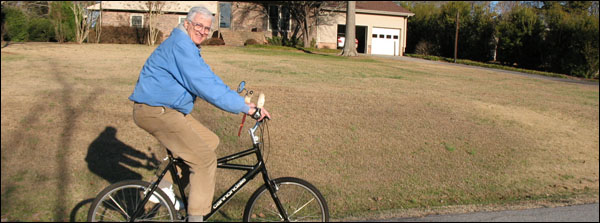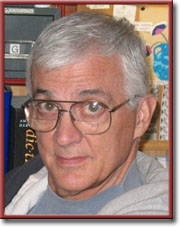The Farther You Go, the Better It Looks: Home
“Clark Gable is remembered as a thrice-divorced and five-time married screen actor, but he understood what ‘home’ meant: a place you approach knowing someone inside is listening for your footsteps. Whether it’s an over-priced Silicon Valley mansion or a canvas tent pitched on a raft, home is a place where your heart has been marinated in the love of those who find shelter under the same roof.” —Skip Eisiminger
Skip the B.S.
By Skip Eisiminger
“The wise woman buildeth her house, but the foolish plucketh it down with her hands.” —Proverbs 14:1
“Do you have cows in your home?” —Bangladeshi woman questioning First Lady Hillary Clinton

CLEMSON South Carolina—(Weekly Hubris)—7/4/2016—Some might say, “A home divided cannot stand,” but few would say, “There’s no place like a house.” Indeed, one Nevada madam flatly stated, “My house is not a home.” No argument there.
As a young man, the father of the novelist Ron Rash casually demonstrated the difference between house and home. Walking to his mill-village residence after he’d picked up the key, Mr. Rash realized that every house in the company-owned compound was identical, so when he reached “home,” he tossed an old boot onto the roof to identify it. I did something similar to the Model “A” Ford I once owned by painting it white. Wisdom begins with a roof, according to a West African proverb, but once the roof is up, the owner often wants to modify and decorate the floors and walls below.
In 2011, the Russian billionaire Yuri Milner reportedly paid $100 million for a single family home in Silicon Valley. California real estate has long been over-priced, but when I read of the transaction, I couldn’t help thinking that the foreign fat cat had been neutered. A few days later, the county tax assessor agreed, saying the house was worth half as much even with 14 baths, an indoor pool, and a sauna. With a slew of other amenities like a private car wash, I doubt if this house will ever be as homey as Huck and Jim’s raft, which cost them nothing. “Other places,” Huck confides, “do seem so cramped and smothery, but a raft don’t. You feel mighty free and easy and comfortable on a raft.” Though Huck is unaware of it, the raft is home because his friend and surrogate father is there, and he loves this white boy like his own children.
Clark Gable is remembered as a thrice-divorced and five-time married screen actor, but he understood what “home” meant: a place you approach knowing someone inside is listening for your footsteps. Whether it’s an over-priced Silicon Valley mansion or a canvas tent pitched on a raft, home is a place where your heart has been marinated in the love of those who find shelter under the same roof.
I grew up in a military family that moved 17 times in 17 years. Yet, like Huck, I always felt that our apartment, duplex, or house was a home because I was loved there. Eudora Welty argued that “one place understood helps us understand all the other places.” In my case, 17 places helped me understand the value of one. Thus, when my wife and I could afford a house, we built one with a tap root and have not seriously thought of moving in 35 years. We joke that we have one move left in us—to the cemetery.
While home for me is 2,300 square feet on Blue Ridge Drive, conductor Bruno Walter felt his home was “the world of classical music.” But as much as I love music, it is but a single feature of home. Though Thomas Wolfe argued that “you can’t go home again,” Robert Frost thought home is “the place where, when you go there, they have to take you in.” Wolfe was effectively contradicted by a poster in a Jewish-American neighborhood that read, “You can go home again. It’s called Israel.” And the place Frost described has always sounded like a state institution smelling of disinfectant.
To the Hollywood director David Lean, “Home is behind a camera.” To the novelist Virginia Woolf, home is a room of one’s own. Strictly speaking, the place behind a camera might be one square foot anywhere in the solar system, whereas a room might be a private but cavernous hall. Hunter-gatherers argue that their bodies are their homes; thus, they tattoo and scarify them the same way Mr. Rash threw his boot on the roof. Finally, Thomas à Kempis observed that “the world is in exile now; home is with God.” My Uncle Ted, a building contractor, would disagree if he were alive, for he felt that owning a home is as close as he or anyone else was going to get to heaven.
Frankly, none of the definitions above resonates with me given the view of the Blue Ridge Mountains I have and the devoted spouse who makes a better marinara sauce than my mother. Part of why I feel so strongly about our split-level is that I helped build it, and I have maintained it over the years, from staining the exterior to painting the bedrooms. “Sweat equity” is what Habitat for Humanity calls it because nothing deepens the pride of ownership like earning the title.
Writing for Time, Roger Rosenblatt observed: “Home is one of nature’s primal forms, and, if it does not take shape properly around the child, then his mind will be at least a little homeless all its life.” Nowhere is that implicit argument better illustrated than in the 1948 photograph of “Tereska” by David Seymour. The subject, a disturbed Polish orphan, is drawing a chalk picture of home, but the viewer needs to know that Tereska was raised at Auschwitz, and her chalk picture is an abstract scribble. I originally wrote “a meaningless scribble” but, of course, the drawing means exactly what Rosenblatt said above. A child raised in a death camp naturally understands “home” as little more than coils of barbed wire shrouded in smoke.
The Biltmore House, which rises in the mountains an hour north of us, was completed in 1895 as a splendid stone pile for the Vanderbilt family—three people in a house of 179,000 square feet. I wasn’t there, but I’ll bet they spent a lot of time in the kitchen trying to stay warm. It seems to me that when money is short, any size structure is fine as long as it’s affordable and dry inside. When money is no object, the size of a house becomes an issue. By trial and error, the Inuit have determined the proper size of an igloo. They know that if the dome is too wide they will freeze to death indoors. And if it’s too narrow, their body heat will cause the structure to collapse, exposing them to the cold.
In 1960, the average American home enclosed about 1,000 square feet; 50 years later, it had more than doubled, and that worries me. On top of drugs, television, computers, violence, unemployment, poor health care, and divorce, the American family should not have to worry about “freezing” in its own home. But as the distance between family members widens, the possibility of a “chill” increases. Thus, if you wish to know the health of the commonwealth, take the temperature of the home.
![]()
Note: Read one viewer’s responses to David Seymour’s photograph here: http://www.sannekabalt.com/blog/tereska-today2712015
![]()
To order copies of Skip Eisiminger’s Letters to the Grandchildren (Clemson University Digital Press), click on the book cover below or contact: Center for Electronic and Digital Publishing, Strode Tower, Box 340522, Clemson SC 29634-0522.



4 Comments
Anita Sullivan
Thanks, Skip, I really enjoyed this a lot. I’m just getting ready to move, with the usual trepidation about making my new house into a home. Your excellent summary puts some perspective on the whole project.
Skip Eisiminger
Always glad to oblige!
I enjoyed your train “trip” as well.
Alex Billinis
“A place where your heart has been marinated in the love of those who find shelter under the same roof.” No better way to describe home.
Skip Eisiminger
Agreed–just don’t drink the marinade.
Skip